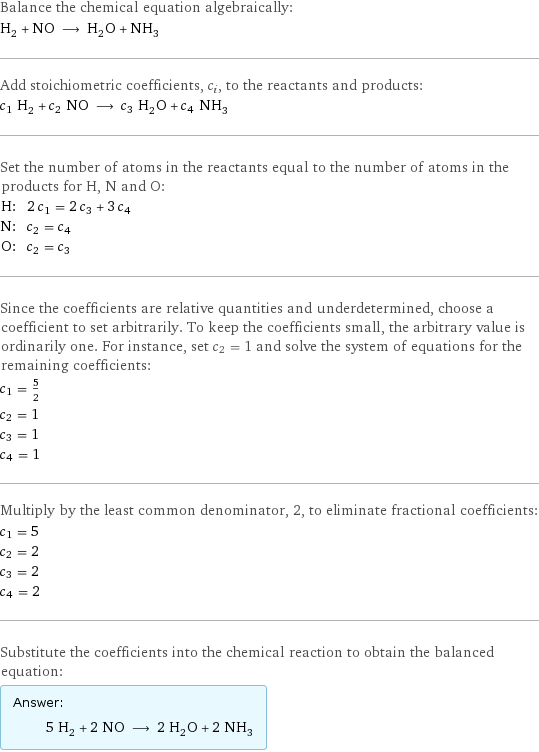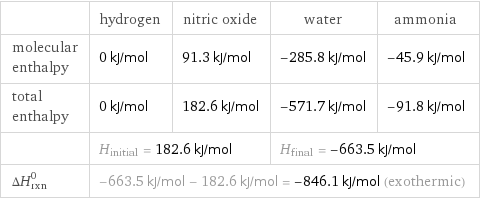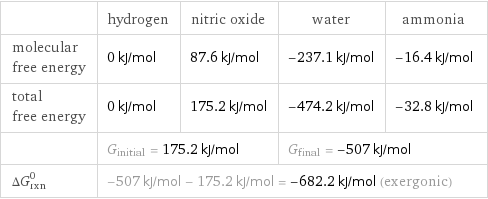Input interpretation

H_2 hydrogen + NO nitric oxide ⟶ H_2O water + NH_3 ammonia
Balanced equation

Balance the chemical equation algebraically: H_2 + NO ⟶ H_2O + NH_3 Add stoichiometric coefficients, c_i, to the reactants and products: c_1 H_2 + c_2 NO ⟶ c_3 H_2O + c_4 NH_3 Set the number of atoms in the reactants equal to the number of atoms in the products for H, N and O: H: | 2 c_1 = 2 c_3 + 3 c_4 N: | c_2 = c_4 O: | c_2 = c_3 Since the coefficients are relative quantities and underdetermined, choose a coefficient to set arbitrarily. To keep the coefficients small, the arbitrary value is ordinarily one. For instance, set c_2 = 1 and solve the system of equations for the remaining coefficients: c_1 = 5/2 c_2 = 1 c_3 = 1 c_4 = 1 Multiply by the least common denominator, 2, to eliminate fractional coefficients: c_1 = 5 c_2 = 2 c_3 = 2 c_4 = 2 Substitute the coefficients into the chemical reaction to obtain the balanced equation: Answer: | | 5 H_2 + 2 NO ⟶ 2 H_2O + 2 NH_3
Structures

+ ⟶ +
Names

hydrogen + nitric oxide ⟶ water + ammonia
Reaction thermodynamics
Enthalpy

| hydrogen | nitric oxide | water | ammonia molecular enthalpy | 0 kJ/mol | 91.3 kJ/mol | -285.8 kJ/mol | -45.9 kJ/mol total enthalpy | 0 kJ/mol | 182.6 kJ/mol | -571.7 kJ/mol | -91.8 kJ/mol | H_initial = 182.6 kJ/mol | | H_final = -663.5 kJ/mol | ΔH_rxn^0 | -663.5 kJ/mol - 182.6 kJ/mol = -846.1 kJ/mol (exothermic) | | |
Gibbs free energy

| hydrogen | nitric oxide | water | ammonia molecular free energy | 0 kJ/mol | 87.6 kJ/mol | -237.1 kJ/mol | -16.4 kJ/mol total free energy | 0 kJ/mol | 175.2 kJ/mol | -474.2 kJ/mol | -32.8 kJ/mol | G_initial = 175.2 kJ/mol | | G_final = -507 kJ/mol | ΔG_rxn^0 | -507 kJ/mol - 175.2 kJ/mol = -682.2 kJ/mol (exergonic) | | |
Entropy

| hydrogen | nitric oxide | water | ammonia molecular entropy | 115 J/(mol K) | 211 J/(mol K) | 69.91 J/(mol K) | 193 J/(mol K) total entropy | 575 J/(mol K) | 422 J/(mol K) | 139.8 J/(mol K) | 386 J/(mol K) | S_initial = 997 J/(mol K) | | S_final = 525.8 J/(mol K) | ΔS_rxn^0 | 525.8 J/(mol K) - 997 J/(mol K) = -471.2 J/(mol K) (exoentropic) | | |
Equilibrium constant
![Construct the equilibrium constant, K, expression for: H_2 + NO ⟶ H_2O + NH_3 Plan: • Balance the chemical equation. • Determine the stoichiometric numbers. • Assemble the activity expression for each chemical species. • Use the activity expressions to build the equilibrium constant expression. Write the balanced chemical equation: 5 H_2 + 2 NO ⟶ 2 H_2O + 2 NH_3 Assign stoichiometric numbers, ν_i, using the stoichiometric coefficients, c_i, from the balanced chemical equation in the following manner: ν_i = -c_i for reactants and ν_i = c_i for products: chemical species | c_i | ν_i H_2 | 5 | -5 NO | 2 | -2 H_2O | 2 | 2 NH_3 | 2 | 2 Assemble the activity expressions accounting for the state of matter and ν_i: chemical species | c_i | ν_i | activity expression H_2 | 5 | -5 | ([H2])^(-5) NO | 2 | -2 | ([NO])^(-2) H_2O | 2 | 2 | ([H2O])^2 NH_3 | 2 | 2 | ([NH3])^2 The equilibrium constant symbol in the concentration basis is: K_c Mulitply the activity expressions to arrive at the K_c expression: Answer: | | K_c = ([H2])^(-5) ([NO])^(-2) ([H2O])^2 ([NH3])^2 = (([H2O])^2 ([NH3])^2)/(([H2])^5 ([NO])^2)](../image_source/87a4e92d40a54f0eedac279872641550.png)
Construct the equilibrium constant, K, expression for: H_2 + NO ⟶ H_2O + NH_3 Plan: • Balance the chemical equation. • Determine the stoichiometric numbers. • Assemble the activity expression for each chemical species. • Use the activity expressions to build the equilibrium constant expression. Write the balanced chemical equation: 5 H_2 + 2 NO ⟶ 2 H_2O + 2 NH_3 Assign stoichiometric numbers, ν_i, using the stoichiometric coefficients, c_i, from the balanced chemical equation in the following manner: ν_i = -c_i for reactants and ν_i = c_i for products: chemical species | c_i | ν_i H_2 | 5 | -5 NO | 2 | -2 H_2O | 2 | 2 NH_3 | 2 | 2 Assemble the activity expressions accounting for the state of matter and ν_i: chemical species | c_i | ν_i | activity expression H_2 | 5 | -5 | ([H2])^(-5) NO | 2 | -2 | ([NO])^(-2) H_2O | 2 | 2 | ([H2O])^2 NH_3 | 2 | 2 | ([NH3])^2 The equilibrium constant symbol in the concentration basis is: K_c Mulitply the activity expressions to arrive at the K_c expression: Answer: | | K_c = ([H2])^(-5) ([NO])^(-2) ([H2O])^2 ([NH3])^2 = (([H2O])^2 ([NH3])^2)/(([H2])^5 ([NO])^2)
Rate of reaction
![Construct the rate of reaction expression for: H_2 + NO ⟶ H_2O + NH_3 Plan: • Balance the chemical equation. • Determine the stoichiometric numbers. • Assemble the rate term for each chemical species. • Write the rate of reaction expression. Write the balanced chemical equation: 5 H_2 + 2 NO ⟶ 2 H_2O + 2 NH_3 Assign stoichiometric numbers, ν_i, using the stoichiometric coefficients, c_i, from the balanced chemical equation in the following manner: ν_i = -c_i for reactants and ν_i = c_i for products: chemical species | c_i | ν_i H_2 | 5 | -5 NO | 2 | -2 H_2O | 2 | 2 NH_3 | 2 | 2 The rate term for each chemical species, B_i, is 1/ν_i(Δ[B_i])/(Δt) where [B_i] is the amount concentration and t is time: chemical species | c_i | ν_i | rate term H_2 | 5 | -5 | -1/5 (Δ[H2])/(Δt) NO | 2 | -2 | -1/2 (Δ[NO])/(Δt) H_2O | 2 | 2 | 1/2 (Δ[H2O])/(Δt) NH_3 | 2 | 2 | 1/2 (Δ[NH3])/(Δt) (for infinitesimal rate of change, replace Δ with d) Set the rate terms equal to each other to arrive at the rate expression: Answer: | | rate = -1/5 (Δ[H2])/(Δt) = -1/2 (Δ[NO])/(Δt) = 1/2 (Δ[H2O])/(Δt) = 1/2 (Δ[NH3])/(Δt) (assuming constant volume and no accumulation of intermediates or side products)](../image_source/e8a00b8315de288ba8f40fcc973e6950.png)
Construct the rate of reaction expression for: H_2 + NO ⟶ H_2O + NH_3 Plan: • Balance the chemical equation. • Determine the stoichiometric numbers. • Assemble the rate term for each chemical species. • Write the rate of reaction expression. Write the balanced chemical equation: 5 H_2 + 2 NO ⟶ 2 H_2O + 2 NH_3 Assign stoichiometric numbers, ν_i, using the stoichiometric coefficients, c_i, from the balanced chemical equation in the following manner: ν_i = -c_i for reactants and ν_i = c_i for products: chemical species | c_i | ν_i H_2 | 5 | -5 NO | 2 | -2 H_2O | 2 | 2 NH_3 | 2 | 2 The rate term for each chemical species, B_i, is 1/ν_i(Δ[B_i])/(Δt) where [B_i] is the amount concentration and t is time: chemical species | c_i | ν_i | rate term H_2 | 5 | -5 | -1/5 (Δ[H2])/(Δt) NO | 2 | -2 | -1/2 (Δ[NO])/(Δt) H_2O | 2 | 2 | 1/2 (Δ[H2O])/(Δt) NH_3 | 2 | 2 | 1/2 (Δ[NH3])/(Δt) (for infinitesimal rate of change, replace Δ with d) Set the rate terms equal to each other to arrive at the rate expression: Answer: | | rate = -1/5 (Δ[H2])/(Δt) = -1/2 (Δ[NO])/(Δt) = 1/2 (Δ[H2O])/(Δt) = 1/2 (Δ[NH3])/(Δt) (assuming constant volume and no accumulation of intermediates or side products)
Chemical names and formulas

| hydrogen | nitric oxide | water | ammonia formula | H_2 | NO | H_2O | NH_3 Hill formula | H_2 | NO | H_2O | H_3N name | hydrogen | nitric oxide | water | ammonia IUPAC name | molecular hydrogen | nitric oxide | water | ammonia